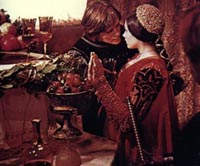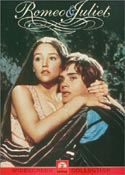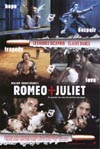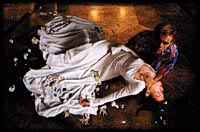“Mad Blood Stirring”: Cross-cultural approaches to Romeo and Juliet
motifs in film
|
|||
| One of William Shakespeare’s most popular plays, Romeo and Juliet has also made its mark in cinema as the stage play most frequently adapted to film. Since 1900, the play has been variously reincarnated on celluloid — by early pioneers Georges Melies and Thomas Edison, as a Golden Age Hollywood extravaganza, embraced by the cinema directors of Egypt, Czechoslovakia, Mexico, Spain, India, Israel, England, Italy, Canada, and the United States. The possibilities in adapting Shakespeare’s tale seem infinite — from filmed stage productions to culturally explicit reinterpretations that retain only the kernel of the Bard’s themes. What makes this play so relevant across centuries of time and continents of distance? Which elements take on prominence when the story is told within a different cultural context? This paper compares three of the major English language film adaptations of Romeo and Juliet, as well as a number of mostly non-English films that use the play’s motifs. Focus films were chosen to explore a diversity of cultures outside the continental European and Elizabethan English source material, and include examples from Japan, the United States of America, India, Wales and Hong Kong. Each of the films discussed has received critical acclaim and/or wide (sometimes cult) popularity, within its genre and often outside its national audience. With the exception of West Side Story, a deliberate rewriting of Shakespeare’s play in a contemporary (1950s) New York setting, the films are not directly adapted from the Romeo and Juliet text but incorporate many or all of the major themes. In all cases, the film creators were undoubtedly familiar with Romeo and Juliet and may have — intentionally or not — explored the similarities. But in any case the most intriguing aspect of studying these films is the adaptability of Shakespeare’s themes to an astonishing diversity of cultural approaches. |
|||
 |
Three major Hollywood productions of Romeo and Juliet have been released, at thirty year intervals. The 1936 MGM film, directed by George Cukor and starring Leslie Howard and Norma Shearer as the doomed lovers, was Hollywood’s first attempt at filming a Shakespearean tragedy. The studio put months of research into creating authentic-looking sets and costumes, and hired a literary advisor to prove that the movie industry could do justice to Shakespeare. The result was a lavish visual spectacle, but the casting of stars too old to play impetuous youth — Howard was 43, Shearer 35, and supporting players Basil Rathbone (Tybalt) and John Barrymore (Mercutio) were 44 and 54 respectively — was a major flaw in portraying the tragic spirit of young love destroyed by fate. |
||
|
The emphasis of this version, a display of Hollywood technical virtuosity and the prominence of the star system, is on the individualism of the characters rather than any larger cultural context. Critics panned the acting as being reverent rather than passionate, and the often posturing characterizations have not held up well over time. The film was nominated for several Oscars and praised for its production values, but was not a financial success; it would be 17 years before MGM produced another Shakespeare film. |
|||
 |
Franco Zeffirelli’s 1968 production avoided the earlier film’s problems by casting two unknown young actors in the main roles. Leonard Whiting (aged 17) and Olivia Hussey (15) certainly looked their parts, if they faltered in speaking the verse. A strong supporting cast, a variety of suitably period Italian locations, and the beauty of the costumes and cinematography made this Romeo and Juliet a box office hit. Stressing the lyrical romanticism and beauty of the love theme in a painstakingly detailed setting, the film had an enormous appeal to college age audiences disillusioned by the Vietnam War escalating around them. |
 |
|
 |
The most recent major film adaptation of the play, Baz Luhrmann’s frenetic William Shakespeare’s Romeo and Juliet, offers an entirely different approach. The modern setting of gang conflict in Miami-esque Verona Beach incorporates gunplay, religious icons, a hip Bard-awareness, fusion of musical styles and thoughtful use of symbolism. It’s thoroughly outrageous, surprisingly effective, and was wildly popular with young audiences. Claire Danes and Leonardo DiCaprio were young and capable enough to portray the lovers, and their scenes together — drenched in the director’s use of water imagery to signify both passion and separation — are full of chemistry. One of the strengths of Luhrmann’s production is the presentation of the conflict between the families which propels the tragedy; the director also chooses to drop the reconciliation scene between Capulet and Montague. The dramatic staging, pounding musical score, and energetic performances by the supporting cast all take a hand in showing the futility of violence fueled by passion. |
 |
|
| Next, 2, 3, 4, 5 | |||